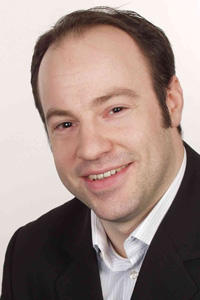Dipl.-Inform. Nicolai Schmittberger

Wissenschaftlicher Mitarbeiter
I joined the working group Computer Systems & Telematics (CST) at the Institute of Computer Science, Freie Universität Berlin in April 2011, after graduation with the degree Diploma in February 2011.
Short CV
| 04/2011 - 08/2012 | Ph.D. student at the Computer Systems & Telematics and Distributed Embedded Systems Group, Institute of Computer Science, Freie Universität Berlin |
| 10/2003 - 02/2011 | Study of Computer Science (major) and Psychology (minor) at the Freie Universität Berlin |
Projects
- Real World G-Lab: G-Mesh-Lab
It becomes more and more obvious that current networking standards and technologies will not satisfy the requirements of the Future Internet. To fulfil these demands, research has to focus on the development and investigation of new approaches. Therefor, the G-Lab project (http://www.german-lab.de/) funded by the German Federal Ministry of Education and Research (BMBF) created a German-wide network laboratory, the German Lab testbed, which currently consists of over 170 nodes. The project is related to the world-wide Planet Lab facility but provides a much more defined setting in terms of homogeneous hardware and full controll over the network architecture. Thus, clean slate approaches could be studied in this project as well as extensions and modifications of existing technologies.
The Future Internet will not only consist of wired nodes but will comprise a huge plurality of hetergeneous wireless systems. On the one hand Mobile Ad-Hoc Networks (MANET) and Wireless Mesh Networks (WMN) based on IEEE 802.2.11 WLAN technology can act as access networks for other clients. On the other hand Wireless Sensor Networks (WSN) and other tiny, embedded systems will form the Internet of Things.
The G-Mesh-Lab project as part of the Real-World G-Lab connects the DES-Testbed to the German Lab in order to study the interconnection of these wireless networks to the Future Internet and determine fitting metrics and protocols to integrate them. Within the scope of this project the testbed gets extended. Several outdoor nodes have been added to fit real-world settings even closer, and, in addition, mobile nodes using a small robot and Android based smart phones are in the process of development. To investigate the feasibility of new protocols like 6LoWPAN for a variety of low power devices such as sensor nodes a real-time capable kernel (µkleos) was developed.
- AVS-Extrem
AVS-Extrem is a use case for Wireless Sensor Networks (WSNs) focused on collaborative, in-network data processing. The goal is to develop a distributed event detection system that can reliably report security relevant incidents (e.g. a person climbing over a fence and accessing restricted areas) to a base station. The vision is that through cooperation of many sensor nodes the accuracy of event detection can be greatly improved, while at the same time saving energy by reducing multi-hop communication with the base station. More information about the AVS-Extreme project is available on the AVS-Extrem homepage.
Publications
- Oliver Hahm, Nicolai Schmittberger, Mesut Günes. Implementation of a TCP/6LoWPAN stack for Wireless Sensor Networks. GI/ITG KuVS Fachgespräch: Next Generation Service Delivery Platforms (KuVS-NGSDP), Berlin, April 2012. (Slides)
- Norman Dziengel, Nicolai Schmittberger, Jochen Schiller, Mesut Günes. Secure Communications in Event-Driven Wireless Sensor Networks. The Third International Symposium on Sensor Networks and Applications (SNA 2011) in conjunction with the Twenty-Fourth International Conference on Computer Applications in Industry and Engineering (CAINE 2011), Honolulu, Hawaii, USA, November 2011. (PDF)
- Bastian Blywis, Mesut Günes, Felix Juraschek, Oliver Hahm, Nicolai Schmittberger. A survey of flooding, gossip routing, and related schemes for wireless multi-hop networks. Technical Report. Institut für Informatik, Freie Universität Berlin, October 2011 (PDF)
- Oliver Hahm, Mesut Günes, Felix Juraschek, Bastian Blywis, Nicolai Schmittberger. An Experimental Facility for Wireless Multi-Hop Networks in Future Internet scenarios. The 2011 IEEE International Conference on Internet of Things (iThings 2011), Dalian, China, October 2011. (PDF)
- Oliver Hahm, Stephan Adler, Nicolai Schmittberger, Mesut Günes. Energy Profiling for Wireless Sensor Networks. GI/ITG KuVS Fachgespräch Sensornetze 2011, Paderborn, September 2011. (PDF)
- Barbara Staehle, Florian Wamser, Sebastian Deschner, Andreas Blenk, Dirk Staehle, Oliver Hahm, Nicolai Schmittberger, Mesut Günes. Application-Aware Self-Optimization of Wireless Mesh Networks with AquareYoum and DES-SERT. EuroView 2011, Würzburg, August 2011. (PDF) (poster) (ScreenCast)
- Bastian Blywis, Mesut Günes, Felix Juraschek, Oliver Hahm, Nicolai Schmittberger. Properties and Topology of the DES-Testbed (2nd Extended Version). Technical Report. Institut für Informatik, Freie Universität Berlin, July 2011 (PDF)
- Nicolai Schmittberger, Norman Dziengel. Sicherheit in ereignisorientierten, drahtlosen Sensornetzen. Informatiktage 2011 (B-IT), Bonn, March 2011. (PDF) (poster)
- Nicolai Schmittberger. Security in Event-Driven Wireless Sensor Networks. Diplomarbeit, Freie Universität Berlin, 2010. (PDF)
Miscellaneous
- Lange Nacht der Wissenschaften 2011
- Lange Nacht der Wissenschaften 2010